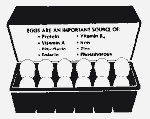

Pssst.... Want to know an easy way to pass your Chemistry class?
The "secret" is called Dimensional Analysis. It's a method that
allows you to convert from one unit to another.
Here's another "secret": You're already familiar with Dimensional Analysis!
You've just never put a name to the process....
For example, when you buy a dozen eggs at the store, how many eggs do you get?
If we take what you just calculated in your head and put it onto paper, we'd have this:
You probably also learned that you can multiply or divide anything by 1:

If you said "twelve", you've just seen Dimensional Analysis in action. You bought 1 dozen eggs, and you know that there are 12 eggs per dozen. You probably didn't write all that down on paper - you just did it in your head. But it worked because somewhere along the line, you learned that if you have 1 dozen of ANYTHING, you have twelve anythings.
12 eggs
1
dozen eggs x ------------ = 12 eggs
1 dozen eggs
4 x 1 = 4 |
6 --- = 6 1 |
25 x 1 = 25 |
14 ---- = 14 1 |
Because we defined this:
1 dozen eggs = 12 eggs
it means that we're just multiplying or dividing by one!
| While you were reading that, my friend called. She swam 1,500 meters yesterday. Can you tell her how many yards that is? She knows that 1 foot = 0.3048 meters. |
1 foot 1,500Hm, that will tell her how many feet she swam, but she wants to know how many yards. Oh, did I mention that 3 feet = 1 yard?metersx -------------- = 4,921 feet 0.3048meters
1 yard 4,921feetx -------- = 1,640 yards 3feet
Putting it all together gives us:
1foot1 yard 1,500metersx -------------- x --------- = 1,640 yards 0.3048meters3feet
Notice how I always cancel out my units.
Always include units in your calculations, and always cancel them out as you go.
If my units aren't canceling out, I probably have a conversion written wrong! Maybe I've written it upside down. Maybe I'm missing a conversion. But if I've done it right, I should be able to get to the units that my answer needs. When I do, it means that I've done all my conversions. Then, and only then, do I take out my calculator and start punching in numbers.
Here's what I mean:
My friend swam 1,500 meters. How many feet did she swim? I know that 1 foot = 0.3048 meters, so I know that I can convert meters to feet. But what goes where?
???
1,500 meters x ----------
???
What happens if I do this:
0.3048 meters
1,500 meters x ---------------
1 foot
1 foot 1,500metersx -------------- 0.3048meters
OK, I've gotten my units to cancel, leaving me in feet, which are the
units I want my answer in. It's only AFTER I've gotten all my units to cancel (except the one I want my answer in) that I'll take out my calculator and
start punching in numbers.
1 foot 1,500metersx -------------- = 4,921 feet 0.3048meters
In other words, the only time you had to use your calculator is at the END, when you're left with only the units your answer requires.
OK, now I have a confession to make. I exaggerated at the beginning of this discussion. Knowing Dimensional Analysis isn't the only thing you'll need to know in order to pass your Chemistry class. Understanding Dimensional Analysis, however, definitely will help you get through the class. You're going to do a lot of conversions, and this method will you to arrive at the correct units - which will in turn get you to the correct answer. Just remember to label your units and cancel them out as you go.
Back to Chemistry Tutorials Home Page